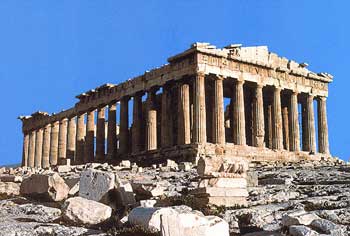 If ancient Greeks had sold postcards to tourists 2,000 years ago, they would have featured vibrant images depicting various perspectives of this famous historical monument.
If ancient Greeks had sold postcards to tourists 2,000 years ago, they would have featured vibrant images depicting various perspectives of this famous historical monument.
Archaeologists indicate that many of the ruins we see today are far removed from their original state. Much of the once brightly painted surfaces have faded over time. They believe that the Parthenon temple in Athens was once adorned with vibrant colors.
It has long been known that this grand marble temple, perched atop the Acropolis of Athens, was painted. Recent examinations conducted by Greek archaeologist and chemical engineer Evi Papakonstantinou-Zioti have confirmed the ancient use of bright colors such as red, green, and blue.
Traces of these colors have been discovered during the ongoing restoration of the temple, which was constructed in 432 BC.
Simply put, the weather has caused the colors to fade over time, remarked Sara Orel, an assistant professor of art history at Truman University in Missouri.
“Sunlight, wind, and damage from modern pollution are the main culprits,” Orel stated. This phenomenon is also seen in artworks on most ancient structures in Egypt, which were painted to stand out against the white stone background. Nowadays, those colors are nearly invisible.
Part of the most exquisite carvings from the Parthenon currently resides in a special display at the British Museum in London. The collection, known as the Elgin Marbles, may have lost some of its colors due to aesthetic principles when it reached London in the early 19th century.
Notably, a restoration effort in the 1930s severely damaged the color of the artworks. A historian from Cambridge University accused museum staff of using metal tools for the restoration work. The issue was that the museum staff shared a common belief, like many others, that these carvings were originally white.
However, Ian Jenkins, in an article published by the British Museum in 2001, defended the restoration work from the 1930s, arguing that it did not transform the Elgin Marbles from their vibrant colors into the white appearance we see today.
“I believe that when the sculpture was brought to the museum, less than 20% of its surface retained its paint,” Jenkins wrote. “The weather is the most significant factor that has contributed to the surface and color of the artwork as we see it today.”
M.T.


















































